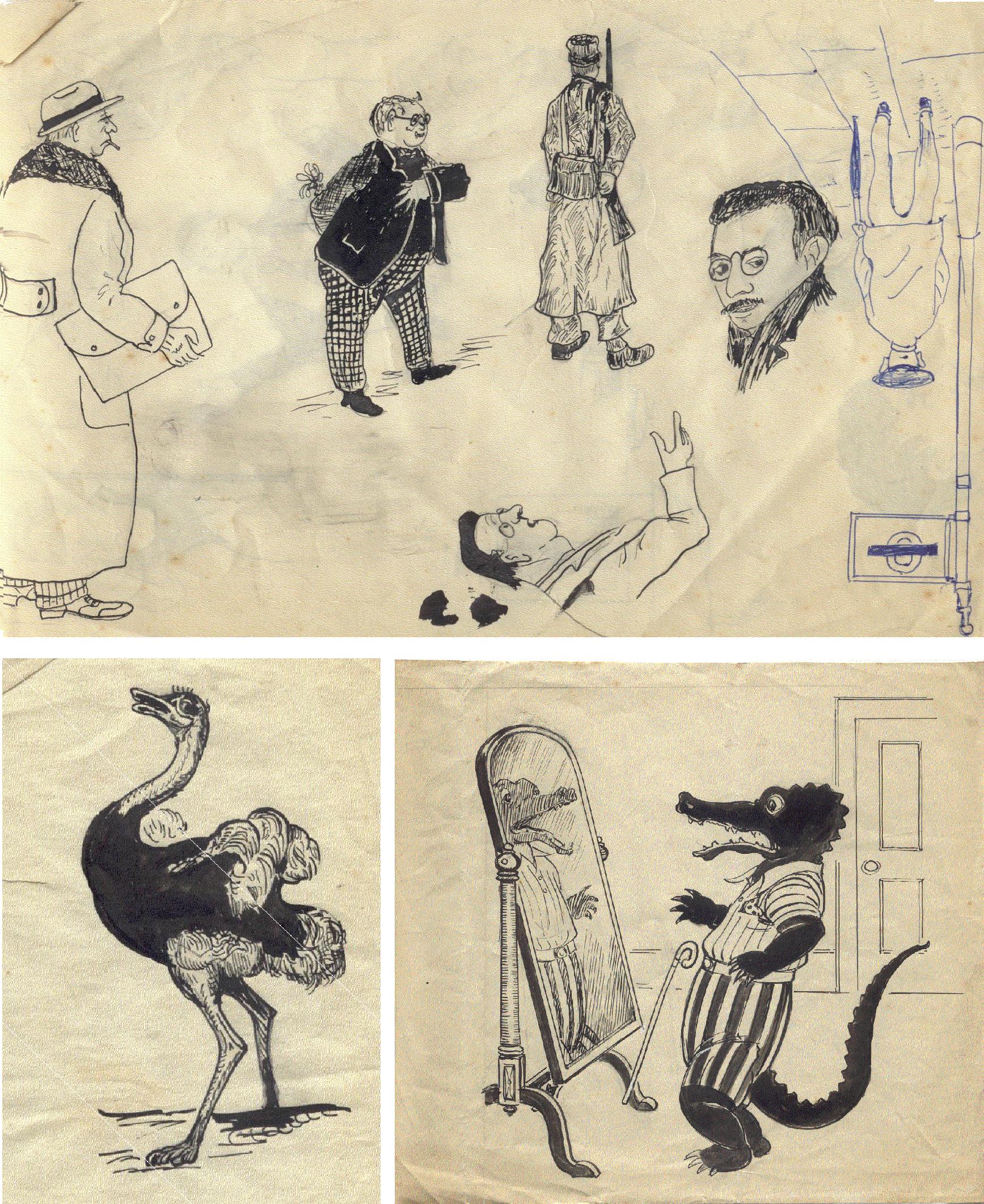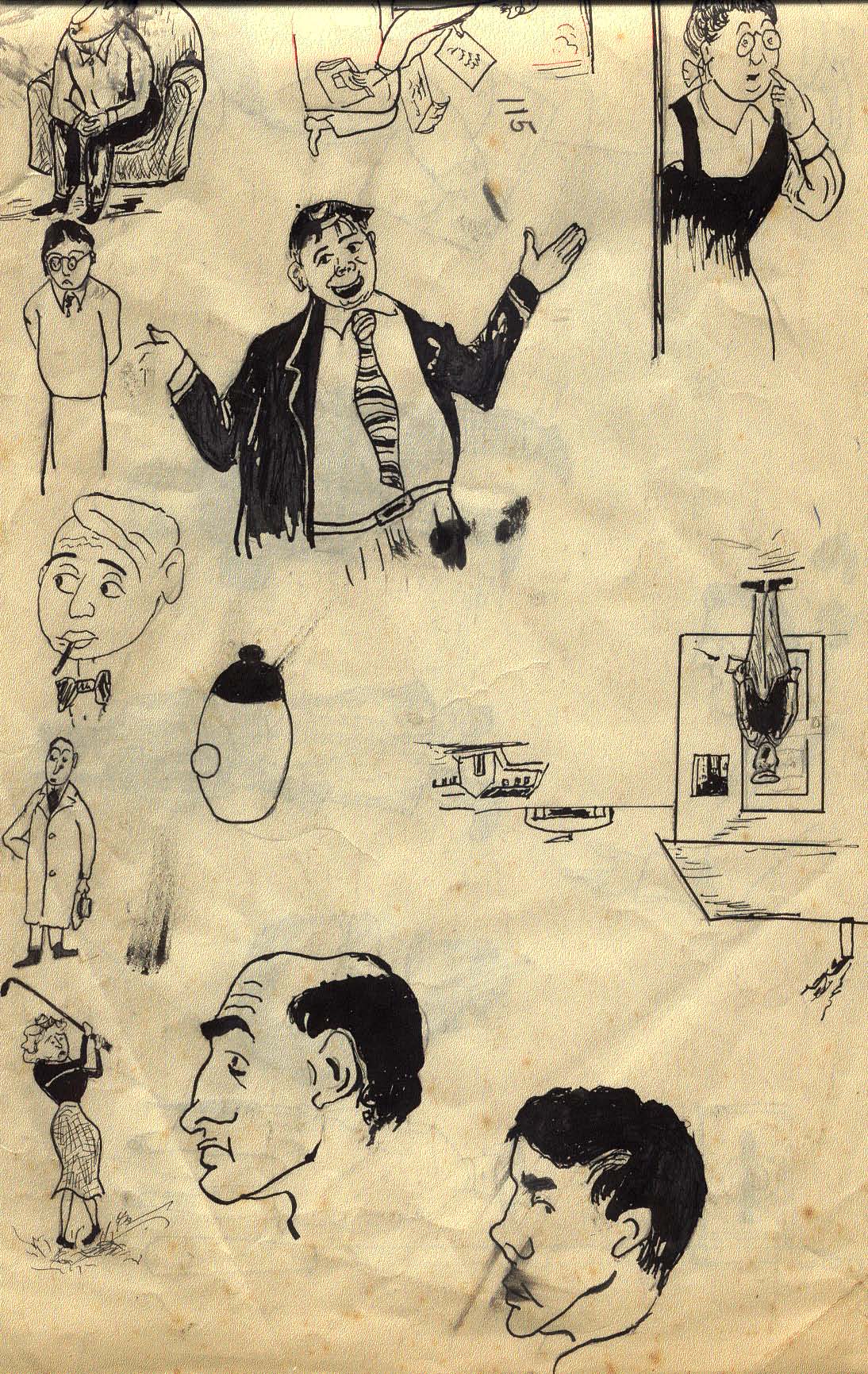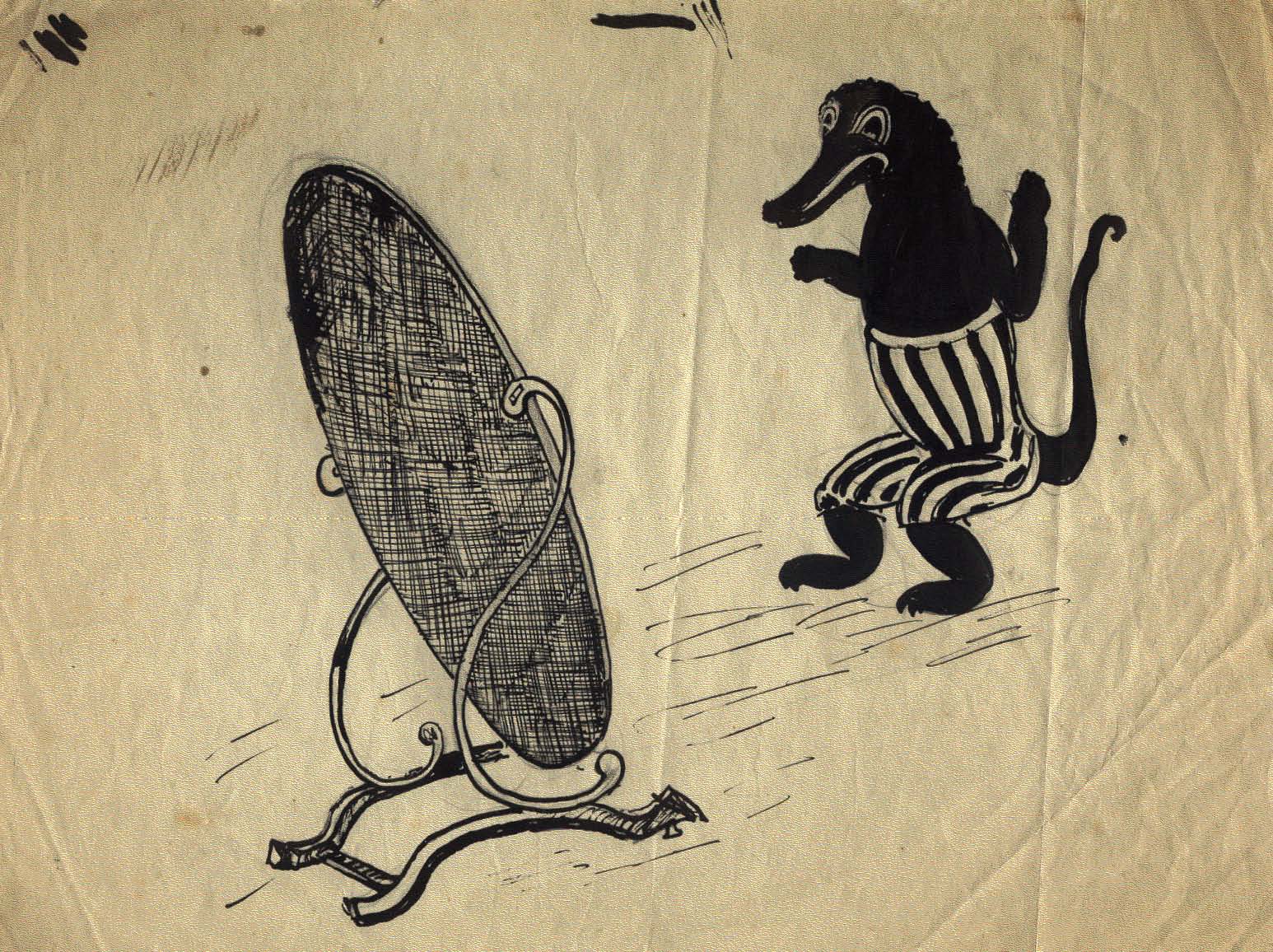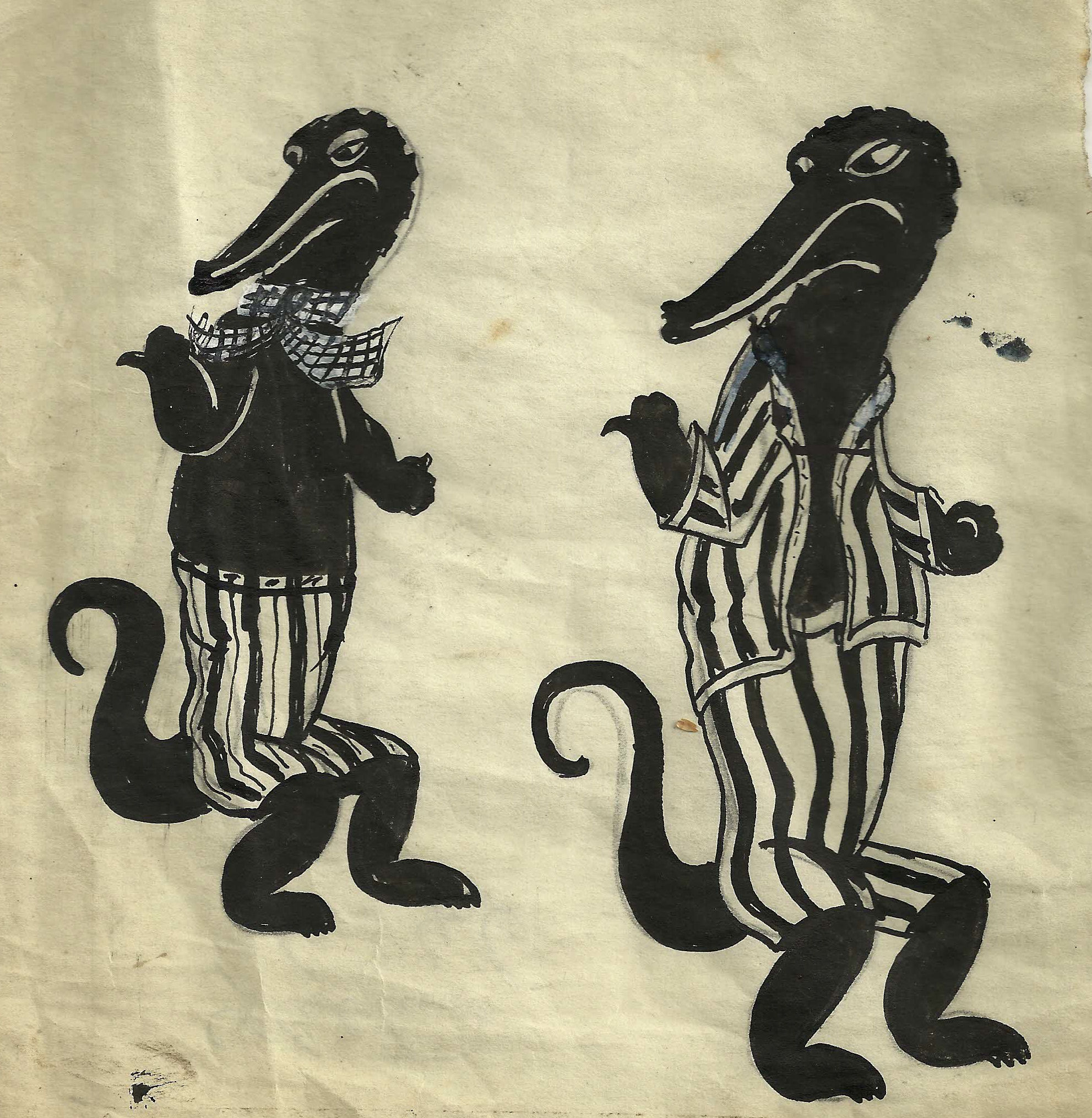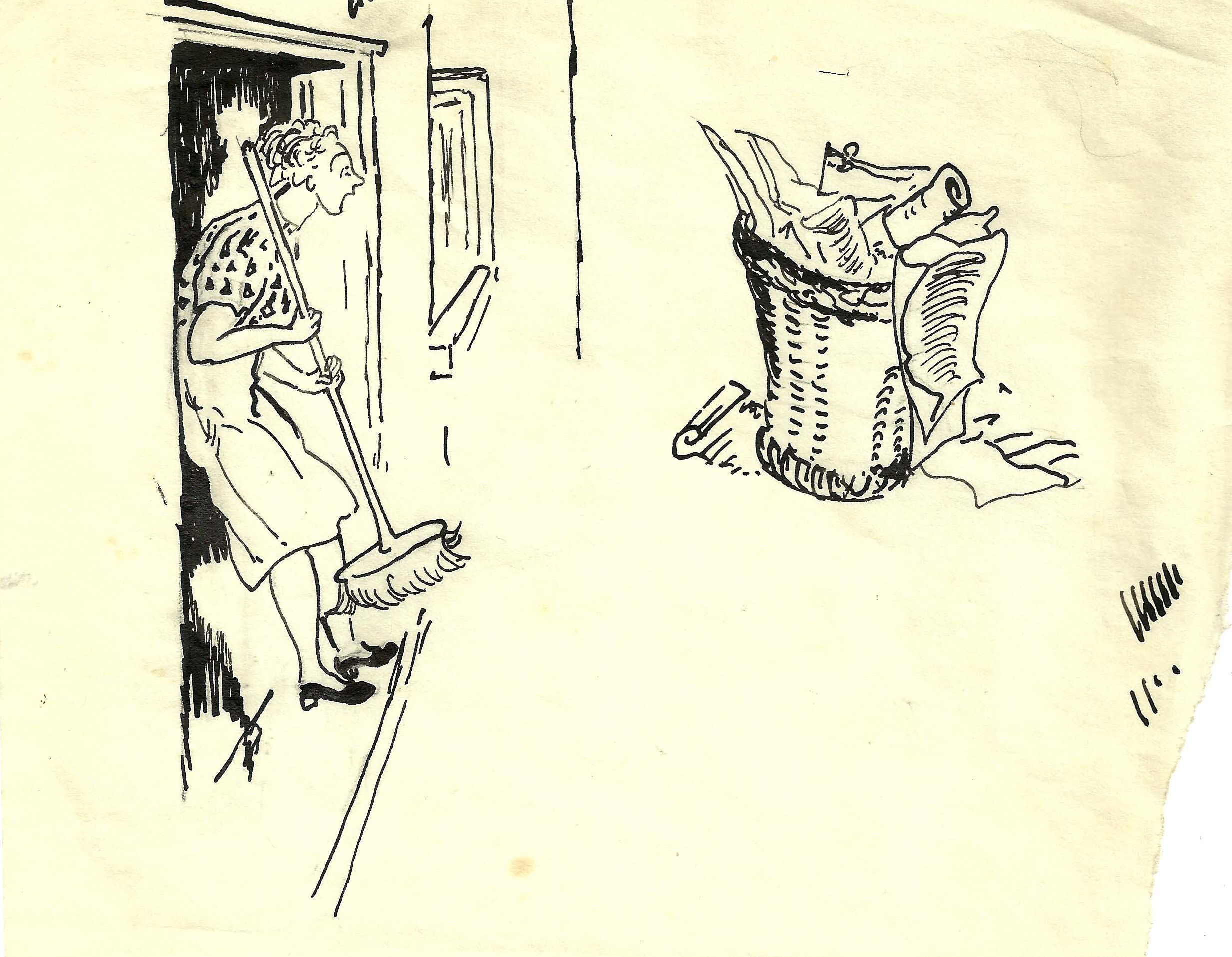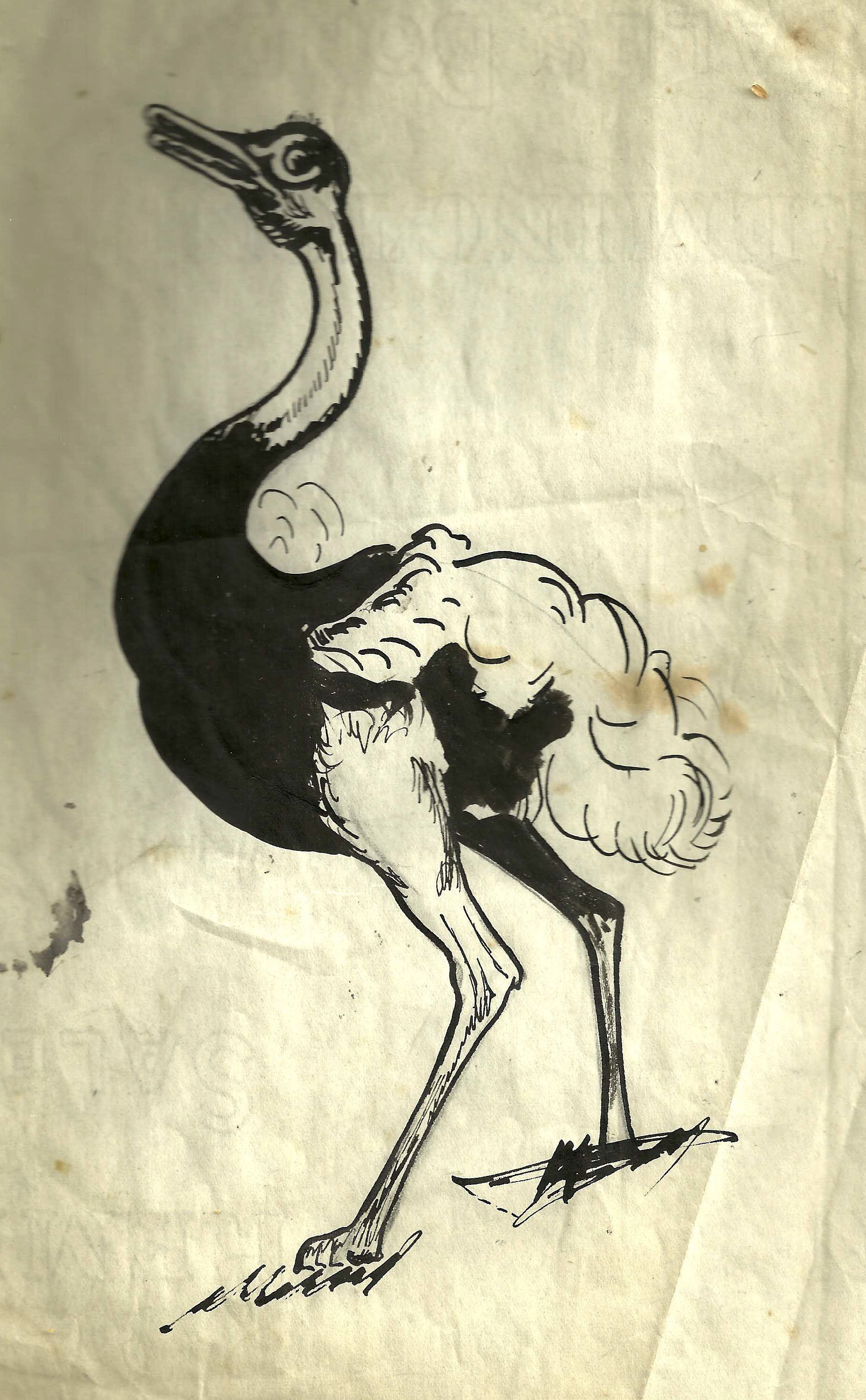

| Home | Books and Story Papers | Hamilton Bibliography | Television and Radio | Ephemera | Hamilton | Acknowledgements | Links |
Biography
Frank Richard's autobiography must have been one of the most unrevealing biographies ever. He omitted most of his early life with the first sentence in the book being "Frank Richards, at 17 was at a loose end". Naveed has scanned the book so you can judge for yourself here.
Several other biographies have appeared in print over the decades, the last being the long awaited biography from his niece Una Hamilton Wright in 2006.
One of my favourites is "The World of Frank Richards" compiled by W.O.G. Lofts and D.J. Adley in 1975. You can read the book here.
Maurice Hall added to the Bio collection in 1990 with his book "I Say, You Fellows". Thanks to Naveed you can read the book here.
Steve Holland wrote an excellent article on Hamilton's life 'After the Magnet'. You can read it here
Latin Acrostic
Allan S recently acquired an unusual item containing two pieces of writing by Charles Hamilton (as Frank Richards) both of which have interesting back stories.
The first writing contains a Latin acrostic found at Cirencester, with some further explanation by Frank Richards.
The literal meaning of the acrostic is “Arepo the sower guides the wheels at work”. However, it is also a cryptogram, by rearranging the letters an alternative sentence is formed “Pater noster esto. O ora et para”, which translated is “He shall be our Father! O pray and prepare.”
What is not stated here is that Hamilton himself worked out this was a cryptogram. In a letter to Jimmy Iraldi dated June 21st, 1960, he refers to the acrostic, and mentions that “I have worked this out as containing a secret message to the Early Christians, using up exactly the 25 letters, as follows: Pater noster esto. O ora et para.”
The acrostic is well known and has a Wikipedia page to itself, where it is called the Sator Square.
Latin parody- The second side of the work contains a handwritten piece of Latin verse and some translation, in Frank Richard’s handwriting, which is unfortunately heavily scribbled out. The wording is as follows:
That is taken from the Venerable Bede’s Latin of which I have made a new meaning referring to my fat friend Billy Bunter
Quamdiu
stabit Bunterus, stabit et Franciscus Ricardus
Quando cadet Bunterus, cadet Ricardus: quando cadet
Ricardus, cadet et ars scribendi juvenibus
In English
While
stands Billy Bunter, Frank Richards stands
When falls Billy Bunter, Richards falls, when
Richards falls, falls the art of writing for the young people
Vita comoedia, in qua ultimus pessimusque jocus est mors
(Translation of last line: Life is a comedy in which death is the
last and worst joke.)
References are made to this piece of writing in at least two places.
In the Collector’s Digest Number 156 (December 1959) Eric Fayne wrote an article called “Frank Richards on Radio” in which he describes a Frank Richards appearance on BBC Newsreel on November 16th (1959). On the show Frank Richards sand three well known songs he had translated into Latin: “There is a Tavern in the Town”, “Waltzing Matilda”, and “The Man on the Flying Trapeze”. Unfortunately, only the translation of Waltzing Matilda was ever published.
After which, Eric Fayne describes the following:
“In a jesting mood, with a real boyish touch, Mr. Richards completed his broadcast with a parody, in Latin, of Byron’s Venerable Bede. And to construe, Mr. Richards obliged: “While Billy Bunter stands, Frank Richards stands, when Bunter falls, Frank Richards falls; and when Richards falls, there will be an end to the art of writing for young people. And so say all of us. Congratulations, Frank Richards. A mighty fine show. May Billy Bunter’s Colosseum stand for a long, long time to come!”
The other reference is made in “The Far Side of Billy Bunter” by Una Hamilton-Wright on pages 239-240. She has a different date and title to the broadcast from Eric Fayne but is undoubtedly referring to the same event.
She also refers to a letter Hamilton wrote which mentioned that:
”The final spot was rather a joke:” he wrote to Dolly, “From
Byron’s Childe Harold:
‘While stands
the colosseum, Rome shall stand,
When falls
the Colosseum, Rome shall fall,
And when Rome
falls, the world!’
This is taken from the Venerable Bede’s Latin, as follows:-
‘Quamdiu
stabit Colosseus, stabit et Roma: quando
cadet
Colosseus, cadet Roma: quando cadet Roma,
Cadet et
mundus.’
I made a new version of this:
Quamdiu
stabit Bunterus, stabit et Franciscus Ricardus quando:
cadet
Bunterus, cadet Ricardus: quando cadet
Ricardus,
cadet et ars scribendi juvenibus
Which being interpreted:
While stands Bunter, stands Frank Richards: when falls
Bunter, falls
Frank Richards, when falls Frank Richards,
also the art
of writing for the young.’”
|
|
 |
Photographs
Letters
Frank Richards was always a prolific letter writer but his output increased after the war when legions of fans started writing to him. Eric Fayne published a booklet with a selection of Hamilton letters from around 1940 until just a few months before his death on Christmas Eve 1961. You can read the booklet here.
The scanned letters here to Bill Gander, CH Chapman and Leonard Packman were from the collection of the late Dr Peter McCall. They were obtained from his daughter Rachael and kindly shared by Naveed and Allan S.
Naveed-
FR letter to
Chapman Feb 14th 1952
FR letter to
Chapman Feb 15th 1952
FR Letter to
Chapman April 12th 1952
FR letter to Chapman 9th Feb 1953 FR letter to Chapman Feb 4th 1955 FR letter to Chapman Feb 26th 1960
FR letter to Chapman Oct 8th 1960 FR letter to Chapman 22nd Feb 1961
FR Letter to Gander 28th Jan 1943 FR Letter to Gander 24th April 1943 FR Letter to Gander 28th Oct 1943
FR letter to Gander April 16th 1945 FR letter to Gander May 15th 1945 FR letter to Gander Jan 9th 1946
FR Letter to Gander 29th July 1946 FR letter to Gander July 4th 1947 FR Letter to Gander 4th November 1948
FR letter to Packman 23rd Dec 1949 FR letter to Packman May 2nd 1950
FR letter to Mr Ashby Jan 7th 1946 FR letter to Mr Ashby Feb 11th 1946 FR letter to Mr Ashby 18th May 1946
FR letter to Mr Ashby Dec 17th 1946
FR letter to Ben Whiter 16th Dec 1949 FR letter to Ben Whiter 20th Feb 1956
BL letter to Mr Austyn 22nd Dec 1976
Allan S-
FR letter to Gander
July 23rd 1943
FR letter to Gander
June 27th 1949
FR letter to
Gander October 8th 1945
FR letter to
Frank Osborn 24 Sept 1947
Allan S recently uncovered a scan of a letter sent by Hamilton to a fan in 1946 where he states that he is still churning out 30,000 words a week on Carcroft, Sparshott, Headland House, Oakhurst, Ferndale and Topham schools. You can read the letter here-
Occasionally original letters turn up for sale. The
following letters were bought by Michael Bailey and he has kindly shared them.
FR Letter to
Ben Whiter 16th Dec 1949
FR Letter
to Geoffrey Cook 13th April 1951
The following letters were kindly shared by Naveed
Haque-
FR
letter to Derek Smith 20th December 1950
FR letter
to Mr Cawley 3rd December 1958
FR letter to Mr
Norman 13th May 1949
FR letter to
Derek Smith 12th May 1952
Naveed recently bought a collection of correspondence between Hamilton and Frank Snell of Bideford in Devon. To do this collection justice I have created a separate page. You can find it here.
And the following are kindly shared by John of
http://www.collectingbooksandmagazines.com who recently discovered them
tucked between story papers from the collection of the late Tom Ebbage-
FR letter
to John Stokes 5th November 1947
FR
letter to John Stokes 18th November 1947.pdf
FR letter
to John Stokes 6th October 1951.pdf
Maurice McLoughlin was the author of the Billy Bunter Christmas stage plays produced in London between 1958 and 1963. His daughter kindly scanned a few letters sent from Hamilton to her Father. You can view them here.
Timothy Campbell was a friend of the late Darrell Swift. On one of his visits to Darrell's house Darrell presented Timothy with an original Hamilton letter that had been sent to John Robyns. John's name cropped up frequently in the CD and he was known as "Red Robby" due to his preference for the Red Magnet. Timothy has kindly shared the scan and you can find it here - FR letter to John Robyns 6th March 1948
Following his success with drawing Bunter picture strips for the Magnet CH Chapman was commissioned to draw similar strips for the Knockout comic. However due to other commitments he was unable to keep up with demand so Frank Minnitt took over. In 1951 Frank wrote to Hamilton and told him that he had been drawing Bunter for the last 14 years. Hamilton replied saying that although no artist he also drew something for that page - a reference to the £5 honorarium paid to him by the publisher every time they used his character. You can see a scan of the letter here.
Letters to William Bagley
In 1944 writer William Bagley contacted Hamilton to request a meeting to discuss an article he wanted to write for The Writer. Hamilton unsurprisingly declined an interview but agreed to an exchange of letters. Bagley sent Hamilton a long questionnaire which Hamilton replied to in some detail. Over the next year or so Hamilton and Bagley exchanged letters and the contents probably provided a better insight to Hamilton's life than his autobiography ever did.
In 2005 the Friars Library published "Frank Richards' letters to William Bagley". This book is no longer in print but copies can occasionally be found for sale via the internet. The ISBN for this excellent publication us 0948708018.
Recently some of the original letters came on to the market and were bought by Allan S and Naveed who kindly agreed to share them here.
Bagley Questionnaire FR to Bagley 1st January 1945 FR to Bagley 11th January 1945 FR to Bagley 18th February 1945 FR to Bagley 28th February 1945
Birth, death, marriage certificates and census returns
Michael and Daniel have kindly supplied the following certificates. Have a look, they provide a fascinating insight into Hamilton's family.
Hamilton parents Marriage certificate Charles Hamilton birth certificate Charles Hamilton Death Certificate
Charles Hamilton 1841 Census Entry Charles Hamilton 1851 Census Entry Charles Hamilton 1861 Census Entry
Charles Hamilton 1871 Census Entry (P1) Charles Hamilton 1871 Census Entry (P2) Charles Hamilton 1881 Census Entry
Charles Hamilton 1891 Census Entry Charles Hamilton 1901 Census Entry
Charles Hamilton Army discharge paper Frank Richards autograph
Christ Church Parish Magazine 1948
Hamilton wrote an article "Thoughts of a Boys Writer" for the Christ Church (Ramsgate) Parish Magazine in 1948. You can read the article here.
Hamilton's Typewriter
Naveed Haque recently acquired the main typewriter used by Charles Hamilton. You can see a clip of Hamilton using it here.
Naveed has created a short video showing the typewriter and other Hamilton articles he has acquired over the years. You can view the video here.
Naveed comments-
"The photos, taken in June 2009, are those of
Frank Richards' principal typewriter. It is a "Remington Standard 10
typewriter". From the serial number I have confirmed that it was manufactured in
January 1922, so the author must have acquired it that very month or any
subsequent date during that particular year.
I am very fortunate in obtaining possession of this
typewriter---indeed as I am somewhat of a Hamilton aficionado, absolutely
'thrilled' would be a better description! This is truly a unique and worth-while
link with the literary life of Frank Richards. The typewriter was owned and
utilized by him from 1922 to December of 1961, when he passed away. It was truly
almost a daily companion, so to speak.
Following the authors passing, it continued to be located in
his study at his home in Kent ('Rose Lawn'), under the care of his house-keeper
Ms. Edith Hood. In 1979, Edith Hood was concerned about the provenance of
certain items owned by the author (including this typewriter) , after she had to
contemplate retiring to a rest home.
Consequently she passed it into the care of the late,
well-known hobby enthusiast Bob Acraman, who displayed it for a time in a
museum-like setting at his own house in Ruislip.
Over the ensuing years, and a move to another home, he was
only too willing to show it to people who were interested. In the early years of
our present century, the typewriter spent a short duration at the Broadstairs
museum, and then was relegated in storage to a back-room in the offices of the
Broadstairs Council, until Mr Acraman's family regained possession.
The typewriter is now proudly owned by Naveed Haque in
Canada, together with two spools of ribbons (with the distinctive purple
colour), that were also the property of Frank Richards.
An interesting aspect is the wearing down of the black enamel
on the right-hand side of the space-bar. This was due to constant use by Frank
Richards over the years! I find the typewriter in ancient, but fairly good
condition. Very stable. Everything works, and the keys are quite clear and
non-faded.
Frank Richards owned an earlier typewriter, which now seems to be lost to
posterity. This had been a Remington Standard no 7 (a 'blind', by which I mean
that the typist could not view the print on the page while typing). As opposed
to this later Remington Standard no 10, where the typist could view the page.
There is some brief mention of both these typewriters of Frank's on pg 151 of
his auto-biography. Mary Cadogan in her biography of Frank Richards also
mentions the typewriters, refer pg 24/25.
The No 7 model initially came out for sale in 1898 (with
quotas in subsequent years), and I believe the prevailing notion is that Frank
Richards purchased a slightly later manufactured model, and retained it from
perhaps 1901 to 1922. Further information on his earlier Remington typewriter
may be found on pg 168 of the autobiography.
In 2020 Naveed acquired Hamilton's backup typer and created a short descriptive video for Friardale showing both typewriters. You can watch the video here.
| Hamilton's Cine Camera. Naveed Haque recently acquired Hamilton's cine camera from the late Betty Acreman. Naveed comments- "The attached photos are those of Charles
Hamilton's personal cine-camera. It was acquired by (Naveed Haque) in 2010 from
Betty Acraman (the widow of the late collector Bob Acraman). You can watch a short video description of the camera and typewriter by Naveed here. |
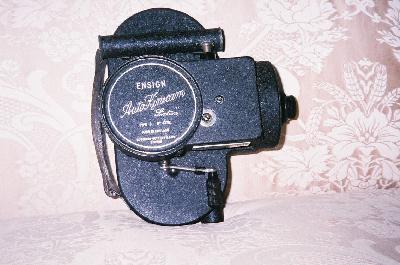 |
|
Hamilton's Cine Projector. Naveed Haque recently acquired Hamilton's cine projector from Roger Acraman. Naveed comments- I already owned Frank Richards former cine-camera (Ensign Auto-Kinecam Sixteen Type B No 1376) for some years. It was given to me by the late Betty Acraman. So you can appreciate how much it meant for myself in 2019 to also obtain Frank Richards cine projector from her son (Roger), as of course any filming our author might have done on the cine-camera was transferred for viewing to this very projector. They complemented each other. The cine-projector is labelled as "Ensign cine-projector no 456", and of course both it and the camera are made in England. As I state in the short video, I am not sure of the year of manufacture for my latest acquisition. Roger Acraman seemed to think it might be the early 1930s, while my initial thought was the late previous decade. My first inclination of the existence of this projector was when I viewed it at the Broadstairs museum in 2003. A number of Frank Richards personal items had been on loan to the museum by the late Bob Acraman, and at that time it was just kept in a back room of the museum and was not on display. In fact it was in several separate pieces (not fully installed), and I was initially even unaware that it was indeed a projector at all! Later on when it came back to the family, Roger took a video of it, and I could see the projector in its full splendour, so to speak. Now I am truly blessed to have it for viewing in 'real time' at my own residence at any juncture of the day. I even imagine our author enjoying the viewing from this now ancient mechanism at Rose Lawn and possibly other places. Today it is rather ancient looking, though there are not any major defects aesthetically. I have not refurbished at all, and of course time has taken its toll on what must have been pristine looks during Frank Richards ownership. I truly appreciate this 1920's/30's cine camera on its own account. Considering further that it was once owned by my very favourite author....my cup of gratitude is truly fulfilled. You can watch a short video description of the projector by Naveed here. |
|
| The Hamilton Museum When Hamilton passed away his will instructed "Now I direct that my trustees shall permit my said housekeeper Edith Elsie Hood to have the exclusive use and enjoyment of my freehold Rose Lawn Kingsgate aforesaid during her life she paying all rates taxes fire insurance and other outgoings in respect thereof.." Edith stayed in Rose Lawn until early 1980 before deciding it was time to move into a nursing home. In all the years she had stayed in the house since Hamilton's death his study remained unchanged. As the house had to be cleared she sought advice from Bob Acraman about what she should do with the contents of the study. Bob agreed to look after the contents by setting up a Hamilton museum in his own home in Ruislip for the benefit of all Hamilton aficionados. The museum was officially opened by Edith Hood 16th December 1979. At each Friars meeting Bob opened the museum and any donations received were sent to Edith. Roger Acraman videoed some of the items in the museum, you can see them here. Additional items belonging to Charles Hamilton can be viewed in the The Charles Hamilton Museum Illustrated created for the London branch of the Old Boys Book Club by the Museum Press. |
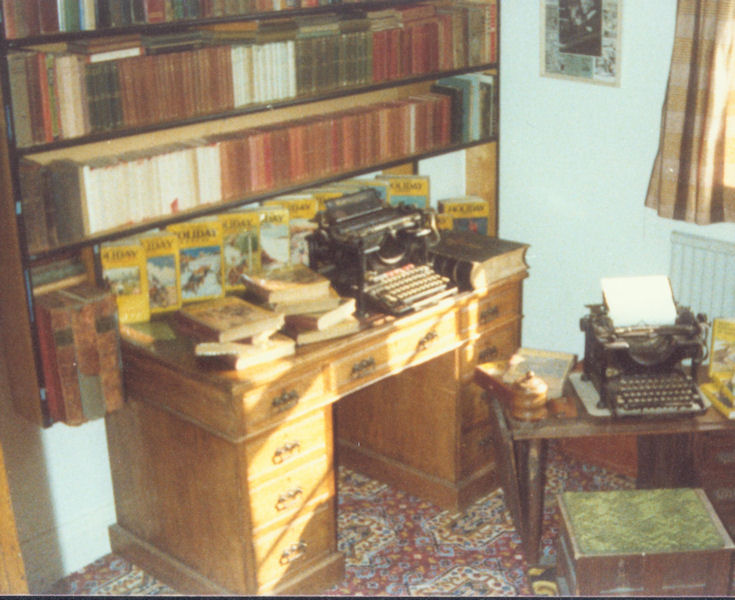 |
The Greyfriars Suite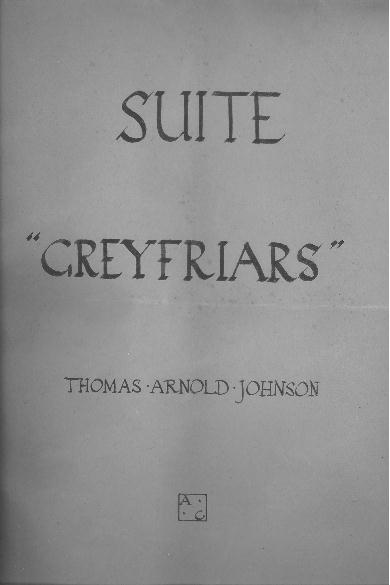
Thomas Arnold Johnson composed "Suite
Greyfriars" in 1948 and dedicated the music to Frank Richards. The works
encompassed music to be played by piano, and dealt with some characters at
Greyfriars (including Billy Bunter). Hamilton and Johnson exchanged a few
letters in 1947 and Eric Fayne included a selection of them in his publication
'The Letters of Frank Richards'. In April 1948
Johnstone visited Frank Richards at Rose Lawn and wrote of his visit in the June
issue of the Collectors Digest. You can read the article on page 146
here.
The Museum press publication of the book honouring
Roger Jenkins: "Do you Remember: Reflections on the Writings of Charles
Hamilton" has a photo of Mr Jenkins playing the suite at a piano in Rose Lawn
circa 1974. The original copy of the manuscript is in the
possession of Naveed Haque. You can download a scan of the manuscript
here.
In early 2012 Nigel Deacon, a friend of the late Tom Johnson was browsing the internet looking for references to Tom's work and was amazed to find a scan of the long lost manuscript for the Greyfriars suite here on Friardale. Nigel recorded the six pieces and has kindly shared them. They can be downloaded from his website here or directly from the links at the bottom of this section.
Nigel provided the following information on Tom Johnson and the Greyfriars Suite-
Many amateur pianists will be
familiar with the name Thomas Arnold Johnson, whom I knew for a period of about
seven years at the end of his life. He was a composer of considerable ability
and produced a lot of music for learners including piano duets, solos, sight
reading and two-piano works, though he is probably best-known for his
arrangements.
He was something of a musical prodigy; Tom's first piano pieces were published
whilst he was still a schoolboy. Whilst at school (aged 15) he had an unusual
part-timejob; he began accompanying films at the local cinema, providing the
musical sound track on the piano, until the talkies arrived. He used Metzler's
Cinema Music, and pieces by Darewski, Ewing, Haines and Ketelbey, as well as his
own improvisations. He had a love of early films and had a comprehensive
collection of film stills in his music room at Neston, where he spent many hours
each day, surrounded by enormous quantities of sheet music and a venerable
work-table.
He would sit at the Bechstein in his green bobble-hat (it was cold in that room
in the winter), exploring some new two-piano piece, sight reading at a
tremendous pace; his perspiring partner trying to keep up, and occasionally
exclaiming 'slow down'!
Up to the age of 20 he was self-taught, but he subsequently studied in
Manchester at the Royal College of Music and obtained his teaching and
performing diplomas. He made many radio broadcasts in the 30s, and gave
recitals, including the first broadcast of the Joachim Raff piano concerto. He
also gave regular talks on music on the wireless. Later on he taught the piano
to private pupils, and wrote large amounts of piano music; most of it was
eagerly snapped up by publishers. Rejected stuff was put onto a pile on the
piano, and re-worked and re-submitted until someone bought it.
He collected sheet music and had a very large amount of material from the 1800s,
including the complete published works of many minor composers: Raff, Jensen,
Hiller, Fibich, Chaminade, Godard, Moszkowski, the Scharwenkas, and so on. With
the help of the Associated Board he produced modern versions of favourite pieces
by minor composers. His starting point for a piece would often be a badly edited
Victorian edition, long out of print, but the only version available.
He had to be pressed to speak about his compositions. To quote C.S.Lewis: 'You
forget all propietorship in your own works. You enjoy them as if they were
someone else's, without pride and without modesty'.
This brings us to the Greyfriars Suite. Tom told me about this in 1988. It's
based on characters from the 'Billy Bunter' stories, which were set in a
fictional public school called Greyfriars, and he had a lifelong affection for
these stories, which were written by Charles Hamilton (pen name Frank Richards).
Tom said ruefully that he had lost his manuscript years ago, and that the pieces
were never published.
In early 2012, nearly 25 years later, I was browsing on the internet to see if
any new Youtube performances of Tom's piano arrangements had been posted. To my
surprise I noticed a reference to 'The Greyfriars Suite', and when I clicked on
it (the 'Friardale' website, www.friardale.co.uk), up came the title page of the
manuscript. I clicked again - and there was a copy, indistinct but complete, of
the whole suite! Incredible. I contacted the webmaster, who was most helpful.
He referred me to the owner of the manuscript, a person living in Canada. The
story goes like this; apparently the manuscript had been given by Tom to Charles
Hamilton, whom he had visited in 1947, and it was in Hamilton's possession for
many years.
Hamilton died in 1961, and the house passed into the possession of his
housekeeper for about 20 years before she moved into a nursing home. When the
house was sold, a well-known Hamilton fan rescued the contents of Hamilton's
study, and moved them into his own house. When he died, his widow sold some of
the stuff, and this was when the present owner of the manuscript acquired it.
The Greyfriars Suite is actually six pieces. No 1 is 'Greyfriars', setting the
scene, and the sort of piece one might play as the children gather for 'school
assembly'.
No 2 is 'Quelchy' - Horace Samuel Quelch; the ms is inscribed "with ashplant".
Quelch was Bunter's form master; an essentially kindly man who occasionally
found it necessary to whack his pupils with a cane (originally a flexible piece
of ash) if they could not or would not learn, or if they misbehaved. One can
actually hear the swish of the cane in the music; a clever piece of writing. It
is a difficult piece to play.
No 3 is an amiable, pleasant piece, 'Bob Cherry', which reflects the character
portrayed; steady, honest and reliable.
No 4 is a definite highlight; William Samuel Bunter, the Fat Owl of the Remove.
You can hear his vast bulk rolling into the quad in the opening bars, and his
silly giggle as he plays a joke on his friends - or steals a cake ...
No 5 is another highlight; Alonzo Todd, Poet and Dreamer, and the other-worldly
music fits perfectly, dying away gently at the end.
No 6 is Harry Wharton and the Famous Five (Bunter's close friends), which brings
the suite to a quiet conclusion, in a similar style to the 'Bob Cherry' piece.
The inscription to Charles Hamilton covers half of the last page, and reads as
follows:
"Greyfriars School, A Suite by Thomas A Johnson: To Frank Richards, in
appreciation of many happy hours spent with his dream children."
I recorded these pieces during the summer of 2012. I am no virtuoso, but hope
you enjoy them. Tom would be delighted that this music is now in circulation
once more.
If you wish to read more about Tom Johnson or hear more of his music, please
click here.
Meanwhile, here are the Greyfriars pieces:
1.Greyfriars
2.Quelchy (with ashplant)
3.Bob Cherry
4.W.G.Bunter
5.Alonzo Todd, Poet and Dreamer
6.Harry Wharton and the Famous Five
Nigel Deacon, England, 31 July 2012
Edith Hood
Edith Hood was Frank Richard's housekeeper and confidant, and resided at Rose Lawn (his home in Kingsgate, Kent) permanently from the early 1930's to beyond 1961 after the author had passed away.
Rose Lawn was in fact made out by the author to be her home for the continuity of her life-time.
Frank Richards met Edith Hood back in the year 1914, after coming from abroad. It was war-time on the continent. He told the taxi driver to take him to a quiet place, and ended up at the village of Hawkinge in Kent.
Frank stayed over the post-office in that village where he rented rooms, and the young daughter of the post-mistress had an equally young nine year old Edith as play-mate and friend. In this way he became acquainted with her. As a teenager she was to later care for his niece Una.
When Ms. Beveridge, Frank Richards regular house-keeper found Rose Lawn for him in later years (the purchase of the home was finalized in December of 1925), this elderly lady carried on as house-keeper for a year or so--but ill-health led to her eventual retirement. It was then that Frank took on Edith Hood (whom he had already occasionally been utilising as an occasional helper) as his regular house-keeper. She was a close platonic friend, and looked after all his domestic wants and gave him good company.
Sometimes a Magnet or Gem story plot was inspired by her relating events that had occurred or that she had heard mention about in her daily routine.
This was in fact a person who was very close to the author in his later years. In 1980, many years after Hamilton's passing, ill-health forced her to leave Rose Lawn, and she passed away in a nursing home in Broadstairs in the year 1989.
A quiet, orderly, modest lady she remains an important personage in the personal history of the author's life.
The letters in this collection mostly deal with mundane affairs and were responses to Ben Whiter (the late brother of Bob Whiter, another ardent enthusiast of Frank Richards). Ben Whiter was at the time of the letters, the secretary of the London Old Boys Book Club, and obviously he kept in touch with Edith Hood enabling members of the Club to visit Frank Richards former house, and welcoming her in turn to Club luncheons.
There are 15 letters, some of them with letterheads in the style of "Rose Lawn", and all are hand-written in Ms. Hood's neat orthography hand (which I should observe are hardly in the more illegible scrawl of a Bunter or Horace Coker of Greyfriars!).
All letters are signed by her, and they span the year 1964 to 1971.
All the originals are currently in the collection of Naveed Haque, who thought it a good idea to share them.
Naveed Comments "What personally strikes me is that Edith Hood seemed very courteous and even welcomed members of the OBBC to visit Rose Lawn itself, and as shown through her concern for an Indian enthusiast of Bunter in one or two of the letters---she was definitely not averse to propagating the works or legacy of her former friend and famed author Frank Richards/Hamilton."Introduction and letters kindly supplied by Naveed Haque. You can read the letters here.
Music
Hamilton, his sister Dolly and her Husband Percy published several songs with Dolly and Percy Harrison providing the music and Hamilton the words. Nigel Deacon kindly played and recorded the music on piano. (Nigel also played the Suite Greyfriars - see above).
You can download the sheet music and the MP3 files from the links below-
| On The Ball! Sheet Music | On The Ball! Music |
| Tell Me, what is Love Sheet Music | Tell Me, what is Love Music |
| The Land of the Far Away Sheet Music | The Land of the Far Away Music |
Broadstairs Celebrity Connections
This was the Frank Richards 'conference' held in Broadstairs, Kent in October 1999. There were other famous celebrities of the past who were on the event list, but Charles Hamilton was one of the subjects for that year with speakers Mary Cadogan, Una Wright (Frank Richards niece) and others in attendance.
Naveed Haque has kindly scanned the booklet and you can read it here. Naveed comments
"Unfortunately I could not attend, but the Festival administrator sent me a letter (included at the end of the scan), in which she included a brief summary of what would be on display in regards to the Hamilton collection on show in Port Regis.
This letter is very interesting to myself , as some of the items on show, once owned by Frank Richards are now in my own possession--but that was not to be for some years until 2007 or so.....such as his typewriter, chess board, cine-camera, books and others varied articles.
However I was fortunate enough to view some of them, and other items later at the Broadstairs museum in 2003 prior to my possession of them.
At the time of the celebrity connections in question, these items were all under the care of Bob Acraman, who I believe also attended this event.
On the whole I am very disappointed not to have attended this 'conference' on Frank Richards, but I am sure there are others who were more fortunate.
In any case, the few scans here will rekindle memories for some, and place for posterity this interesting past event related to our favourite author."
Drawings and Doodles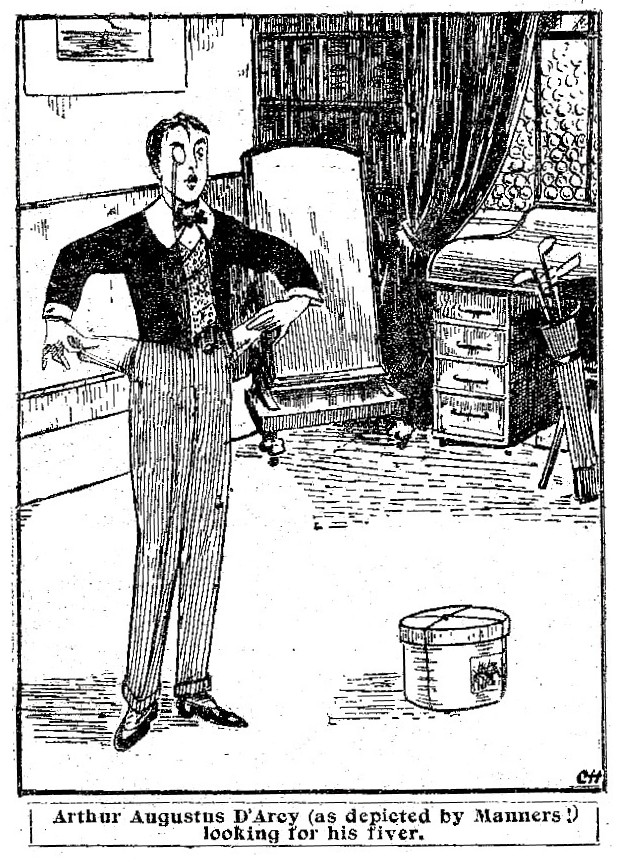
Hamilton enjoyed drawing and proved himself a competent artist by having one of his drawings appear in the Gem issue 176. The drawing shows D'Arcy looking for his 'fivah' and is supposedly by Harry Manners. Only the observant would notice the 'CH' initials on the bottom RH corner.
Charles Hamilton was also fond of 'doodling' and a number of his doodles have appeared in various publications. Naveed has recently bought some original doodles and has kindly provided scans for Friardale.
Naveed comments "The depicted drawings, or
what I allude to as 'doodles' are authentic by Charles Hamilton (Frank
Richards), and were for a time in the possession of the late Bob Acraman. He got
the permission of Frank Richard's housekeeper Edith Hood in 1979 to make them
available for potential viewing, in addition to some other Hamilton items, in a
museum setting at Ruislip, England. The amateur 'museum' was officially opened
by Edith Hood herself in a ceremony. The first doodle was published in the late
Maurice Hall's biography.
Subsequently in later years the drawings ended up with the Broadstairs museum
for a duration, but were not publicly shown in a display.
The originals of these Frank Richard drawings, in addition to a further three original pages of Hamilton doodles/drawings, are presently in the
collection of Naveed Haque".
